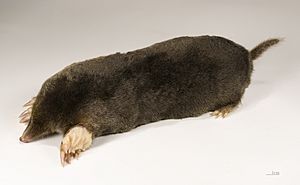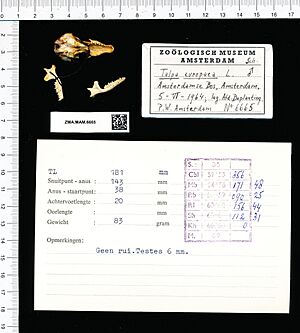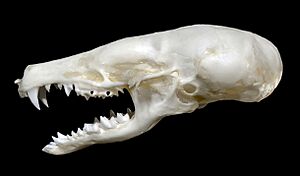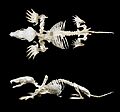European mole facts for kids
Quick facts for kids European mole |
|
|---|---|
 |
|
| Conservation status | |
| Scientific classification | |
| Genus: |
Talpa
|
| Species: |
europaea
|
 |
|
| European mole range | |
The European mole (Talpa europaea) is a small mammal that lives underground. It is also known as the common mole or the northern mole.
This mole builds many tunnels underground. It uses these tunnels to find its food. When a mole digs, it pushes the extra dirt to the surface. This creates the small hills you might see, called molehills. The European mole eats many things, so it is an omnivore. It mainly eats earthworms, but also insects, centipedes, and even small mice or shrews. Its spit has a special chemical that can make earthworms unable to move.
Contents
Where European Moles Live
The European mole lives in many parts of Europe and western Asia. You can find them as far north as the United Kingdom and southern Scandinavia. They live as far south as northern Greece, and as far east as western Siberia. In most of these places, it is the only type of mole you will find.
For a long time, people thought the Loire River in France was a border for these moles. They believed it separated the European mole from another type, the Aquitanian mole. However, scientists have found both types of moles on both sides of the river. This means they can sometimes live in the same areas.
What European Moles Look Like
The European mole has a body shaped like a tube. It is about 11 to 16 centimeters (4 to 6 inches) long. It usually weighs between 70 and 130 grams (2.5 to 4.6 ounces). Female moles are often a bit smaller than males.
Their eyes are tiny and hidden under their fur. Their ears are just small bumps on their skin. The fur is usually dark gray. But moles can have many different fur colors, like white, light gray, tan, or black. Since they live underground, having different fur colors does not cause them any problems.
Where Moles Make Their Homes
Moles usually live in their tunnel systems. But the European mole does not always stay underground. In spring and early summer, young moles leave their mothers' tunnels. They need to find new places to live. This means they come out of their burrows to dig new tunnels or find empty ones.
In summer, they might dig closer to the surface. This could be because the ground is harder then, making it tougher to dig deep. European moles also like to live near drainage lines and streams. However, they do not live in places that are flooded or too dry. If their usual homes get flooded, dry areas become important.
The type of soil, plants, or how high up a place is does not usually affect where moles live. The most important thing for a mole population is how many earthworms are in the area. In city green spaces, a mole family needs about 10 hectares (25 acres) to survive. More space means more mole homes.
The Life Cycle of Moles
The European mole has a short breeding season in the spring. Mating happens over a few weeks in March and April. After that, the mother mole is pregnant for about four to five weeks. Most baby moles are born in late April or early May.
A mother mole usually has between two and seven babies at a time. The babies drink their mother's milk for four to five weeks. By the end of June, the young moles usually have to leave their tunnels. European moles typically live for three to five years.
What Moles Eat
Many people think European moles eat their own weight in food every day. But this is not quite true. Studies show that they eat about half of their body weight in food each day.
When moles are kept by humans, they will eat many different things. This includes liver, small mice, mealworms, shrews, and maggots. But they like earthworms the most. In places where there are not many earthworms, insects become their main food. Moles eat both young (larval) and adult insects.
How Moles See
Because European moles live underground, their eyes are not like ours. Their eyes are only about 1 millimeter (0.04 inches) wide. They are buried under their fur and have a simple lens.
Even though their eyes are small, moles can still tell the difference between light and dark. They can also see some movement and even some colors. Scientists think that moles use their vision to spot predators that might break into their tunnels.
How Moles Hear
European moles do not have outer ears like humans do. Because of this, they are thought to hear low sounds very well. Their inner ear is also special.
Studies show that sound travels well through a mole's head, especially low sounds. It is thought that the ears of a mole work in a unique way for a mammal. This system has been seen in reptiles, amphibia, birds, and crickets.
How Moles Grow Their Bones
As a European mole grows, its bones develop in special ways. Many changes happen in its backbone, especially in the neck and chest areas. These changes help the mole have a strong body and neck right after it is born. This helps them start digging.
When a baby mole starts to crawl and dig, the bones in its front paws that help with digging begin to harden. Some bones in their hands, called distal phalanges, are actually the first to harden. These bones help support the digging action.
Mole Teeth
The shape of an animal's teeth is very important to scientists who study fossils. Teeth can tell them a lot about ancient animals. Unlike fur color or other features that do not fossilize, teeth last a long time. Studying teeth helps scientists understand the differences between fossil animals and classify them.
The Roman mole (Talpa romana) used to be thought of as the same species as the European mole. They are similar in size. The main differences are that the Roman mole has eyes covered by skin and a different hip bone shape. Even though their bodies are similar, the Roman mole's teeth are much larger than the European mole's. The European mole has small teeth for its size.
Images for kids
-
An albino European mole, which has white fur.
See Also
- Nova virus - a virus first found in European moles.
- Mole (animal) - for more general information about moles.








